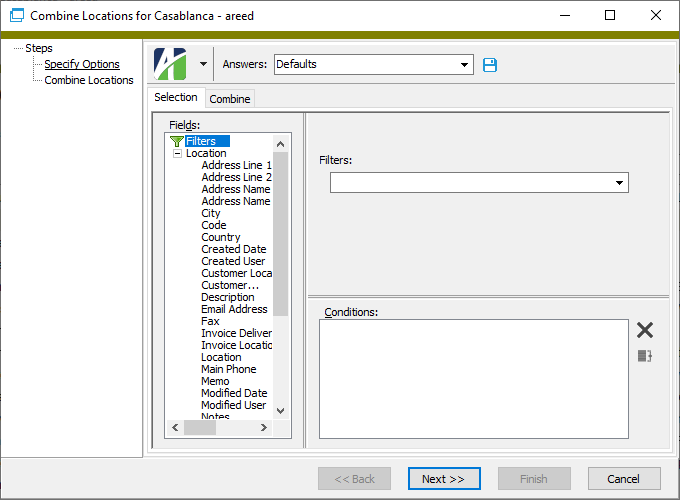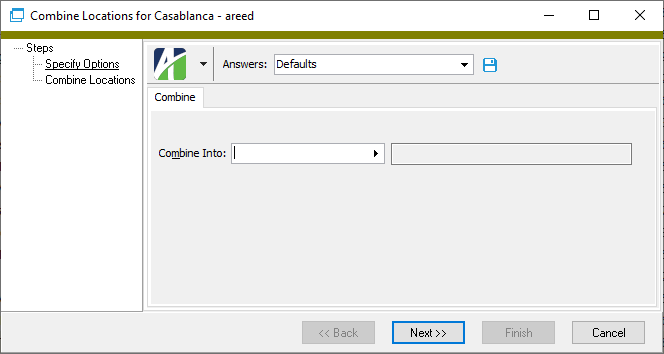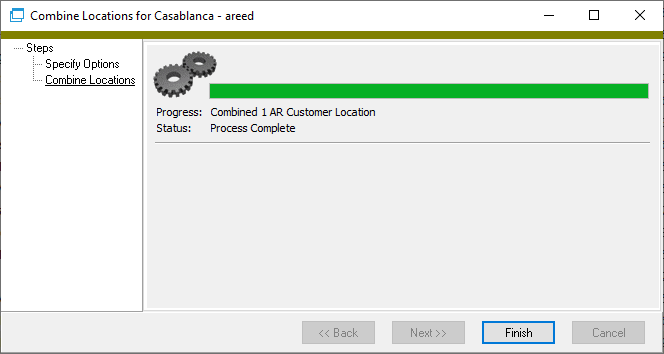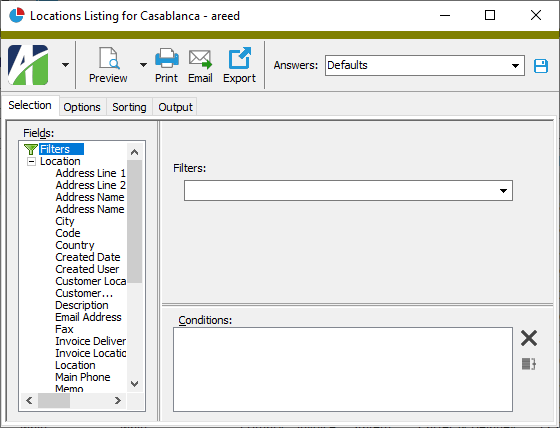A customer location stores address and phone information for an AR customer. A customer can have multiple customer locations. You can associate a customer contact with one customer location.
Customer locations are used on customer records, invoices, receipts, and statements. You can designate a location as the primary customer location, the invoice location, and/or the statement location for a customer. For invoice and statement locations, you can designate whether to deliver items by email or as a printed document.
Note
Customer locations must be created before creating customer contacts.
You can create customer locations from the Locations folder or from a customer record on the Locations tab. The difference is that when you create a location from the customer record, some of the fields are prefilled for you.
Create an AR customer location
- In the Navigation pane, highlight the Accounts Receivable > Customers > Locations folder.
- Click
 . The New Location window opens.
. The New Location window opens.
- In the Customer field, select the customer code associated with the customer location.
- Enter a unique Code for the customer location. The code must be unique among other locations for the same customer. You can use up to 30 characters.
- Enter a Description of the customer location.
-
If the customer location is the primary location for the customer, mark the Primary checkbox.
Note
Only one customer location can be flagged as the primary location. If you flag a location as primary and another location is already flagged as primary, ActivityHD removes the primary designation from the other customer location record.
-
If the customer location is the location where invoices for the customer should be sent, mark the Invoice checkbox.
Note
Only one customer location can be flagged as the invoice location. If you flag a location as the invoice location and another location is already flagged as the invoice location, ActivityHD removes the invoice designation from the other customer location record.
-
If the customer location is the location where statements for the customer should be sent, mark the Statement checkbox.
Note
Only one customer location can be flagged as the statement location. If you flag a location as the statement location and another location is already flagged as the statement location, ActivityHD removes the statement designation from the other customer location record.
- In the Address section, enter name and address details for the customer location.
- In the Tax Entity field, select the default tax entity to use as the destination tax entity on new invoices for the customer location. If you leave this field blank, the default origin tax entity is used instead.
- In the Salesperson field, select the default salesperson to use on new invoices for the customer location. If you leave this field blank, the default salesperson from the customer record is used instead.
- In the Phone section, enter one or more phone numbers for the customer location including the Main and Fax numbers.
-
In the Internet section, enter the customer location's Email and Web Site addresses. Both fields produce hyperlinks when you enter an address. If you press Ctrl+click on the Email field contents, your mail client will open with a pre-addressed email. If you press Ctrl+click on the Web Site field, your browser will open to the specified Internet location.
Note
If the location is the invoice and/or statement location and you need to specify multiple recipients for invoices and/or statements, you can enter multiple email addresses separated by semi-colons.
- In the Invoice Delivery field, select the method to use to deliver invoices whenever the customer location is listed on an AR invoice. This method can be overridden when you print invoices. Your options are:
Note
If you select "Email", you must enter an email address in the Email field.
- In the Statement Delivery field, select the method to use to deliver statements whenever the customer location is listed on an AR invoice. This method can be overridden when you print statements. Your options are:
Note
If you select "Email", you must enter an email address in the Email field.
- Save the new customer location.
To combine customer locations, the target customer location and the source customer location(s) must be associated with the same customer. Any notes and attachments associated with the source location(s) are added to the notes and attachments for the target location.
To combine two or more customer locations:
Combine AR customer locations
- In the Navigation pane, highlight the Accounts Receivable > Customers > Locations folder.
- Start the Combine wizard using one of the following methods:
- To use filters to select the source location(s) to combine:
- Right-click the Locations folder and select Select and Combine from the shortcut menu.
- On the Selection tab, define any filters to apply to the data.

- To hand-select the source location(s) to combine:
- In the HD view, select the source location(s) to combine. You can use Ctrl and/or Shift selection to select multiple locations.
- Click
 .
. - On the Combine tab in the Combine Into field, select the target location.

- Click Next >>. ActivityHD prompts you to confirm that you want to combine the selected locations.

- Click Yes.

- When the process is complete, click Finish.
AR Customer Locations Listing
Purpose
The Locations Listing provides a list of the locations associated with your customers.
Content
For each customer location included on the report, the listing shows:
- customer name
- customer location code
- customer location description
- whether the location record has been flagged as obsolete
- whether the location is the customer's primary location
- whether the location is the customer's default location for sending invoices
- whether the location is the customer's default location for sending statements
- customer's preference for invoice delivery
- customer's preference for statement delivery.
In addition, you can include one or more of the following:
- details (address, phone numbers, email, website address, default tax entity, default salesperson)
- timestamps
- memos
- custom fields.
The following total appears on the report:
- record count.
Print the report
- In the Navigation pane, highlight the Accounts Receivable > Customers > Locations folder.
- Start the report set-up wizard.
- To report on all or a filtered subset of customer locations:
- Right-click the Locations folder and select Select and Report > Locations Listing from the shortcut menu.
- On the Selection tab, define any filters to apply to the data.

- To report on specifically selected customer locations:
- In the HD view, select the customer locations to include on the report. You can use Ctrl and/or Shift selection to select multiple records.
- Click
 .
.
- To report on a particular customer location from the Location window:
- In the HD view, locate and double-click the customer location to report on. The Location window opens with the customer location loaded.
- Click
 .
.
- To report on all or a filtered subset of customer locations:
- Select the Options tab.

- Mark the checkbox(es) for the additional information to include:
- Details
- Report Options. To include a section at the end of the report with the report settings used to produce the report, leave the checkbox marked. To produce the report without this information, clear the checkbox.
- Timestamps
- Memos
- Custom Fields (only visible if custom fields are set up)
- Select the Sorting tab.

- In the Available Sort Options list box, highlight the field(s) to sort the report by, then click
 to move your selection(s) to the Assigned Sort Options list box.
to move your selection(s) to the Assigned Sort Options list box. - If you selected multiple sort fields, use
 or
or  to arrange the sort fields in the order you want them applied.
to arrange the sort fields in the order you want them applied. - Select the Output tab.
- In the Design field, look up and select the report design to use.
- In the toolbar, click the icon for the type of output you want:
 - Provides access to two preview options.
- Provides access to two preview options.- Preview - Click the icon or click the drop-down arrow and select Preview from the drop-down menu to view the report in the Crystal Reports viewer.
- Preview to PDF - Click the drop-down arrow next to the icon and select Preview to PDF to view the report in the PDF reader.
 - Opens the Print dialog so that you can select and configure a printer and then print a paper copy of the report.
- Opens the Print dialog so that you can select and configure a printer and then print a paper copy of the report. - Opens the Report Email dialog so that you can address and compose an email that the report will be attached to. For best results, ensure your email client is running before you attempt to send a report via email.
- Opens the Report Email dialog so that you can address and compose an email that the report will be attached to. For best results, ensure your email client is running before you attempt to send a report via email. - Opens the Export Report dialog so that you can save the report to a file. File types include Crystal Reports (.rpt), PDF (.pdf), Microsoft Excel (.xls), Microsoft Word (.doc), rich text (.rtf), and XML (.xml).
- Opens the Export Report dialog so that you can save the report to a file. File types include Crystal Reports (.rpt), PDF (.pdf), Microsoft Excel (.xls), Microsoft Word (.doc), rich text (.rtf), and XML (.xml).
Data extensions
The following data extension is available for the report:
- Locations
Location Record ID
The customer associated with the location. This field is disabled after the location is saved.
Press F3 to look up the value.
If a value is already selected, you can press F4 to open the record in its native editor.
If this checkbox is marked, indicates the location is the customer's primary location.
Note
Only one customer location can be flagged as the customer's primary location. If you flag a location as the primary location and another location is already flagged as primary, ActivityHD removes the primary designation from the other customer location record.
If this checkbox is marked, indicates this is the location where the customer's invoices should be sent.
Note
Only one customer location can be flagged as the invoice location. If you flag a location as the invoice location and another location is already flagged as the invoice location, ActivityHD removes the invoice designation from the other customer location record.
If this checkbox is marked, indicates this is the location where the customer's statements should be sent.
Note
Only one customer location can be flagged as the statement location. If you flag a location as the statement location and another location is already flagged as the statement location, ActivityHD removes the statement designation from the other customer location record.
Location tab
Use the fields in this section to provide address information for the customer location.
The tax entity to use as the default destination tax entity when a new invoice is entered for the customer location. If you do not specify a default here, the default destination tax entity on a new invoice is the origin tax entity from the invoice.
Press F3 to look up the value.
If a value is already selected, you can press F4 to open the record in its native editor.
The salesperson to use as the default salesperson when a new invoice is entered for the customer location. If you do not specify a default here, the default salesperson on a new invoice is the default salesperson from the customer record.
Press F3 to look up the value.
If a value is already selected, you can press F4 to open the record in its native editor.
One or more phone numbers for the customer location.
The email address for the primary contact at the customer location. The email address becomes a hyperlink. To launch your email client with an email pre-addressed to the location contact, press Ctrl+click.
Note
If this location is the invoice and/or statement location and you need to specify multiple recipients for invoices and/or statements, you can enter multiple email addresses separated by semi-colons.
The method to use to deliver invoices when the customer location is listed on an AR invoice. This method can be overridden when you print invoices. Your options are:
-
Email
Note
If you select this option, you must enter an email address in the Email field.
The method to use to deliver statements when the customer location is listed on an AR invoice. This method can be overridden when you print statements. Your options are:
-
Email
Note
If you select this option, you must enter an email address in the Email field.
Custom tab
This tab is visible if custom fields exist for the entity. At a minimum, if there are custom fields, a Fields subtab will be present. One or more additional categories of subtabs may also be visible.
Fields subtab
This tab prompts for values for any custom fields set up for entity records of this entity type. Respond to the prompts as appropriate.
References subtab
This tab is visible if other records reference the current record.
Example
Suppose a custom field exists on PRCodes that references an ARCode. On the ARCode record, on the Custom > References subtab, you can view all the PRCodes which reference that ARCode.
Exchange Folder subtab
This tab is visible only if you set up a custom field with a data type of "Exchange Folder". The label on this tab is the name assigned to the custom field.
This tab shows the contents of the specified Exchange folder.
File subtab
This tab is visible only if you set up a custom field with a data type of "File". The label on the tab is the name assigned to the custom field.
This tab renders the contents of the specified file according to its file type.
Internet Address subtab
This tab is visible only if you set up a custom field with a data type of "Internet Address". The label on this tab is the name assigned to the custom field.
This tab shows the contents of the specified web page.
Network Folder subtab
This tab is visible only if you set up a custom field with a data type of "Network Folder". The label on this tab is the name assigned to the custom field.
This tab shows the contents of the specified network folder.
Data Links tab
See "Data Links".
Notes tab
The Notes pane shows the Notes HD view filtered to show all notes for the selected customer location.
Double-click a row in the pane to drill down to its record in the Note window.
Attachments tab
The Attachments tab is visible if any record for a given entity has an attachment. If the Attachments tab is not visible, this implies that no record of the entity type has an attachment on it; however, once an attachment is added to any record of the entity type, the Attachments tab will become available.
Change Logs tab
This tab is visible if the user has "Change Logs" access to the associated data folder resource.
The Change Logs pane shows the Change Logs HD view filtered to show all change logs for the selected entity record.
Double-click a row in the pane to drill down to its record in the Change Log window.
Other tab
Developer tab
This tab is visible only when developer features are enabled.
Automation subtab
This subtab shows field names and values for the current data record. Use the information in the subtab to assist when creating automation objects such as bots and import files. The field names and field values can be copied from the text box and pasted directly into your code or application. To copy content from the text box, highlight the content to copy and press Ctrl+C or right-click your selection and select Copy from the context menu.
Export (XML) subtab
This subtab shows the XML syntax for exporting the selected data record. The syntax can be copied from the text box as an exemplar for creating your own automation objects for bots, import files, ActivWebAPI, etc. To copy content from the text box, highlight the content to copy and press Ctrl+C or right-click your selection and select Copy from the context menu.
Import (XML) subtab
This subtab allows you to select a file for import and shows the XML syntax for importing data records. Use the subtab to explore the XML syntax for importing data records. In particular, you can investigate the syntax which results when using Data.Import and ActivWebAPI data POST and DELETE routes.
Change Log (XML) subtab
This subtab is visible only when the Enable Change Logs option is marked in System Options or Company Options (depending on whether the feature applies at the system or the company level). This is the default setting when developer features are enabled.
This subtab allows you to investigate changes to the current data record. The syntax can be copied for use in bots, dashboards, ActivWebAPI, and other automation. To copy content from the text box, highlight the content to copy and press Ctrl+C or right-click your selection and select Copy from the context menu.
Select Statement (SQL) subtab
This subtab allows you to investigate the SQL select statement used to retrieve the current data record. The syntax can be copied as an exemplar for data sources and other automation. To copy content from the text box, highlight the content to copy and press Ctrl+C or right-click your selection and select Copy from the context menu.

|
|
Customer locations security
Common accesses available on customer locations
| Access | A user with this access can... |
|---|---|
| Change | Use the mass change action on customer locations. |
| Change Logs | |
| Custom Fields | Create and edit custom fields for customer locations. |
| Data | Have read-only access to customer locations from anywhere in the software (e.g., field validations, filters, date expressions). |
| Delete | Delete customer locations. |
| Edit | Edit customer location records. |
| Export | Export customer location records from ActivityHD. |
| Import | Import customer location records into ActivityHD. |
| New | Create new customer location records. |
| Read | Have read-only access to customer location records. |
| Report | Run reports with customer location information. |
| Report Designs | Create and edit report designs with customer location information. This access enables the Report Designs button on the Output tab of report dialogs. |
| Shared Answers | Create and edit saved answers related to customer locations. |
| Shared Filters | Create and edit shared filters on customer locations. |
| Visible | View the Locations folder in the Navigation pane. |
Special accesses available on customer locations
| Access | A user with this access can... |
|---|---|
| Combine | Combine customer location records. |
Location filters
The following built-in filter is available for customer locations:
| Filter Name | Effect |
|---|---|
| ? Customer Code | Prompts for a customer code and lists the customer locations for that customer code. |
Report Email dialog
- Windows user default account. Sends email using the user's Windows default email account. For most users, this is the account configured in Outlook or another email client application.
- Server personal. Sends email using the email configuration for the system or company server and the email address on the current user's authorized user record. The authorized user record must have a confirmed email address.
- Server generic. Sends email using the email configuration and "from" address for the system or company server. This option requires "Send generic" access to the Server Email resource.
|
5225 S Loop 289, #207 Lubbock, TX 79424 806.687.8500 | 800.354.7152 |
© 2025 AccountingWare, LLC All rights reserved. |